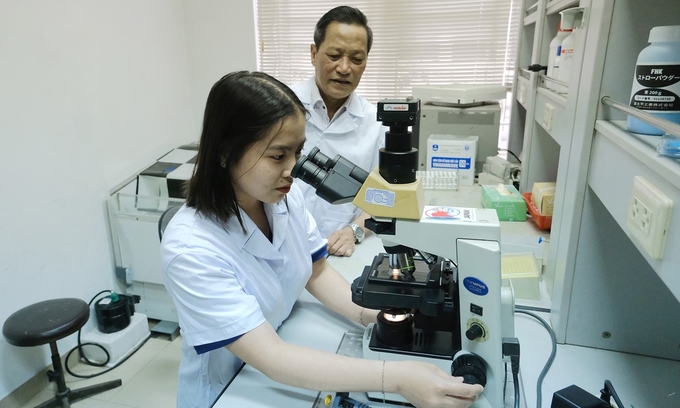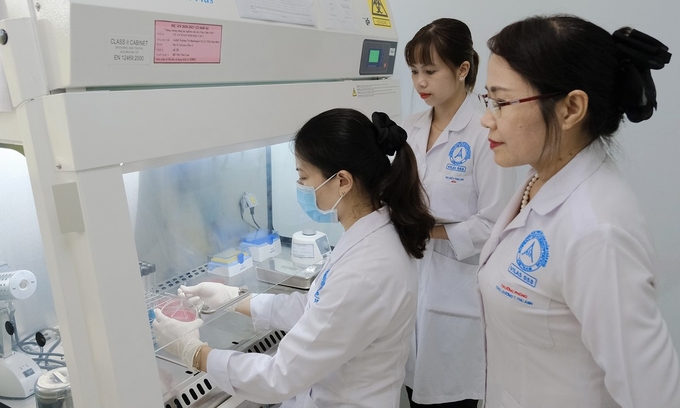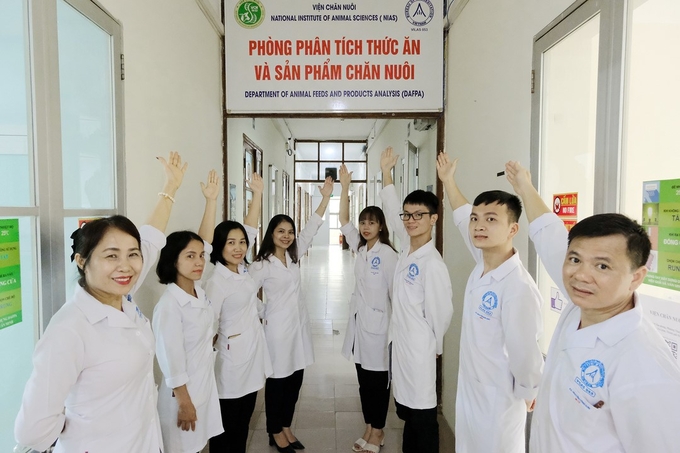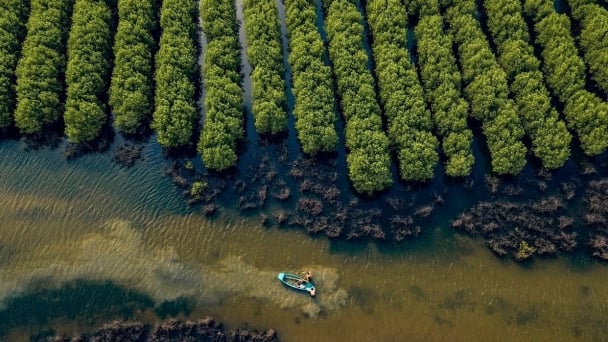June 14, 2025 | 16:24 GMT +7
June 14, 2025 | 16:24 GMT +7
Hotline: 0913.378.918
June 14, 2025 | 16:24 GMT +7
Hotline: 0913.378.918
Discussing scientific research activities in the context of many institutes of science operating under an autonomous mechanism, Vietnam Agriculture News recently had an interview with Mr. Pham Cong Thieu, Director of the National Institute of Animal Science (NIAS).

Director Pham Cong Thieu supervises the process of creating cloned embryos. Photo: Bao Thang.
It is a fact that many scientific works by public research institutes have not been commercialized. In your opinion, where does the cause come from?
This actual situation derives from three main reasons. First, many scientific research projects and topics have not really come from the requirements of production reality. This is the most important factor that makes scientific work lack applicability.
Second, most of the present topics and projects are proposed in reverse, which means the topics and projects are proposed by scientists instead of receiving orders from state management agencies or production-directing agencies such as the Department of Agriculture and Rural Development of provinces or the Department of Livestock Production (in the specific case of NIAS).
Third, funding for research is becoming increasingly tight. Not only that, but the allocation process remains spread, lacking focus and a focal point. Thereby, emerging the phenomenon of "trimming the feet to fit the shoes", e.g., a project is proposed at VND 10 billion but only VND 3 billion is approved, so the final product is incomplete and not highly applicable in production.
To solve the problem, provincial science departments and central management agencies should now re-systematize the problem according to each field, then synthesize and send official dispatches to institutes of science and research agencies. On the basis of that suggestion, the scientists discuss what to prioritize to solve first and how to optimize the budget and research so that the product can be sold after research is completed, avoiding the situation of scientific work "putting it in a drawer".

Livestock sperm freezing practice at the National Institute of Animal Science. Photo: Bao Thang.
The government, ministries, and branches are now calling for associating research with the market. In order for this work to be effective, what changes do the relevant parties need to make in their operations?
Public research institutes that want to reform their operational structure must continue to train human resources, i.e., scientific and technical staff. It is necessary to have a team of highly qualified professionals who are good at both theory and practice. In the future, institutes will need to train leading experts in each field and create key research groups to create breakthroughs in research.
Whether the research is successful or fails, the staff must always be concerned with the idea and, at the same time, coordinate with specialized agencies in both horizontal and vertical industries to strengthen market forecasting. In addition, the institutes continue to strengthen their material facilities and equipment to meet future scientific research tasks.
Vietnam's economy is in the process of integration, so institutes of science should actively expand international cooperation to take advantage of this resource. Thanks to that, we can train our team and exchange experiences with international scientists to get an experimental basis in our own homeland.
It is impossible to forget the funding sources from localities. In my opinion, this is the place where the most demand is arising because it is often difficult for the locality to organize an in-depth research team to come up with strategic plans. Scientific research requires commitment, dedication, and even sacrifice, but in return, leaders of institutes of science must always think and explore to create jobs and increase income for staff so that they can keep their minds on their work.
From the side of the state management agency, we would like to continue to receive support on policies, including enhancing the treatment of researchers and even creating an open mechanism instead of attracting first and treating later like before. In addition, investment material facilities for research activities of institutes and universities also need to be periodically evaluated by the institutes and universities, which do not have the same resources as enterprises. Without early investment and attention, the scientific system is in danger of becoming increasingly atrophied.

The head of the Animal Feeds and Products Analysis Department, Ms. Duong Thi Thu Anh, supervises the process of microbial sample culture. Photo: Bao Thang.
From the reality of its own activities, how has NIAS oriented and planned so that the research products can gain a foothold in the market?
In Vietnam, it is clear that we have a strong research team without a shortage of material facilities or land. However, institutes still face challenges in promoting the performance of their staff, and scientists' lives have not improved. These things pose an urgent need to untie the mechanisms of science and technology.
Since its establishment in 1952, most of the institute's research results have been transferred to production. In the context that the percentage of small farmer households in Vietnam is still relatively large, the institute’s mission over the past few years has been ensured because we have determined that the main target service object is farmers. Some basic research with high applicability, such as research on spermatozoa and embryos, embryo transplants, or cloning, is always paid attention to by the institute.
As the head of the National Institute of Animal Science, I believe we must continue to promote our advantages; here is the genetic material source and the indigenous livestock genetic source in Vietnam to continue to select and breed. On that basis, create Vietnamese-branded livestock varieties that are adapted to Vietnam's soil and climate conditions for production transfer.
Vietnam is one of the countries that is highly valued for its biodiversity, including indigenous livestock genetic resources. Therefore, NIAS will continue to deploy the work of preserving, restoring, and transplanting specific and endemic genetic resources in order to serve mainly household farmers and, in the future, create high-quality OCOP products.
Another spearhead of the institute is to focus on research on probiotics and medicinal preparations to gradually replace antibiotics in livestock, develop organic livestock, meet food safety and hygiene standards, treat livestock waste, and treat livestock environments.
In the face of the continuously increasing pressure on animal feed, the institute's research team has been working on processing, preserving, and using public, agricultural, and aquatic by-products to create feed ingredients to further promote the role of animal husbandry in society.

NIAS currently has three professional rooms, five subject rooms, one research room, 10 centers, and one key laboratory. Photo: Bao Thang.
There is an opinion that in order for the institute of science to be truly "untied", it is necessary to have support mechanisms and policies so that the institute can operate as a business model. What is your opinion on this idea?
This is not a new problem because the budget from the state is always limited, while many institutes of science now operate under an autonomous mechanism. If the public non-business unit is entitled to some regimes and policies like an enterprise, for example, the right to lease properties if not used up, or a joint venture or association in the use of land, it is really good.
The research institute-enterprise model can be considered ideal because one party has knowledge and experience and the other has resources and capital. In some countries around the world, people have deployed this approach to create new resources and dynamics for the economy and society.
Thank you, sir!
Translated by Huyen Vu

(VAN) In Tien Giang, a high-tech shrimp farm has developed a distinctive energy-saving farming model that has yielded promising results.
![Turning wind and rain into action: [3] 300.000 farmers benefit from agro-climatic bulletins](https://t.ex-cdn.com/nongnghiepmoitruong.vn/608w/files/news/2025/06/12/e5a48259d6a262fc3bb3-nongnghiep-125122.jpg)
(VAN) The agro-climatic bulletin has become a valuable tool for farmers in the Mekong Delta. After more than five years of implementation, the initiative is gradually being expanded nationwide.
![Turning wind and rain into action: [2] Providing forecasts to the people](https://t.ex-cdn.com/nongnghiepmoitruong.vn/608w/files/news/2025/06/12/e5a48259d6a262fc3bb3-nongnghiep-103927.jpg)
(VAN) In addition to improving the quality of hydrometeorological forecasts, putting forecast bulletins into practical use is crucial for production and disaster prevention.

(VAN) Blue carbon is receiving attention for its rapid absorption capacity and vast potential. It represents a promising nature-based solution to respond to climate change.
/2025/06/11/3507-1-161904_583.jpg)
(VAN) Seagrass beds and coral reefs serve as 'cradles' that nurture life in the ocean depths, creating rich aquatic resources in Vietnamese waters.
![Turning wind and rain into action: [1] Forecasting for farmers](https://t.ex-cdn.com/nongnghiepmoitruong.vn/608w/files/news/2025/06/11/e5a48259d6a262fc3bb3-nongnghiep-111919.jpg)
(VAN) Weather is no longer just a matter of fate. Forecasts have now become an essential companion for farmers in every crop season.
/2025/06/10/2501-3-082025_983.jpg)
(VAN) Mr. Le Hoang Minh, Head of Vinamilk's Net Zero project, recently shared insights on the integration of production, energy, and technology in Vinamilk’s green transition journey.